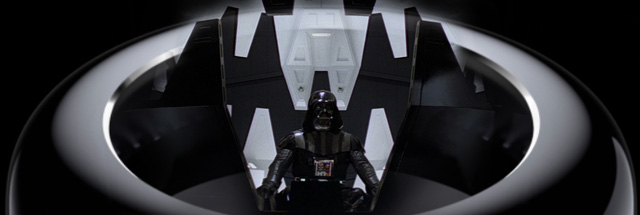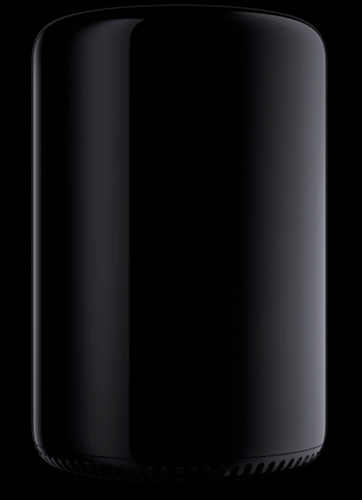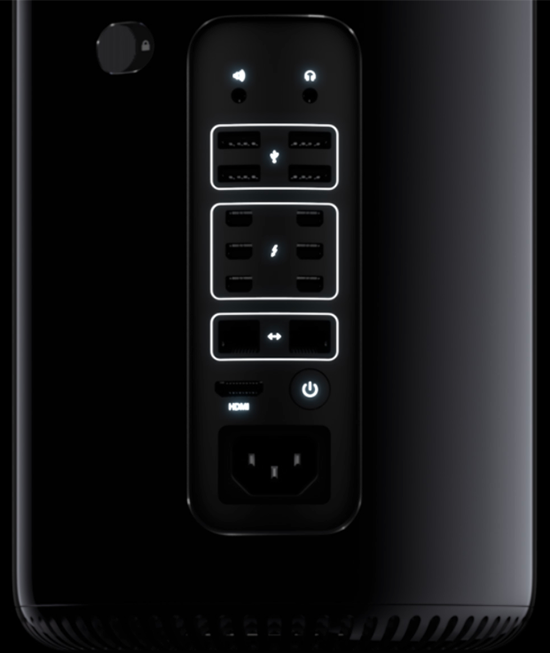
Hell finally froze over yesterday and Apple announced a new Mac Pro at WWDC. At first glance, the new machine was as mysterious as it was terrifying to me and many other creative pros who have been waiting for ages for this thing to drop. But now that Apple has a full site page for the new machine and I’ve gotten some info from people familiar with its internals and with OS X 10.9, the Mac Pro has become less of a mystery.
But that’s also what’s freaking us out.
The design
At 6.6" × 9.9" for its cylindrical stretched aluminum case, the new Mac Pro is tiny, and no other workstation-class Xeon desktop with a discrete workstation GPU—or two, in this case—looks anything like it. You get the feeling that the designers sat around coming up with ideas for the new Mac Pro and said, “If Darth Vader edited video, what would his computer look like?” Well... it would probably look like this:

If you haven’t seen the inside already, it’s a truly amazing bit of engineering, organized in a tube-like shape with a triangular arrangement of the motherboard elements along the exterior walls of the “thermal core,” a unibody-like heatsink that draws heat away from the GPU, CPU, and memory:

Even more unusually, the machine has only one (1!) fan that cools everything, wind-tunnel style:

So the Mac Pro will, I suspect, be a ridiculously quiet workstation as well. This is Apple engineering at its best, and I won’t have any concerns about using this for long sessions of V-Ray rendering or ZBrush sculpting. Detractors will say it’s going to overheat if you do anything serious, but Apple knows these things need to run around the clock for days on end. It didn’t put a dual workstation GPU in there and expect people not to use it extensively. More about that further on.
The new Mac Pro makes the previous generation look (thankfully) as outdated as it should, given that the machine it’s replacing uses technology from 2010. All the expected modern technologies are here, plus some that will put the new machine ahead of many current competing workstations: dual Gigabit Ethernet, HDMI 1.4, Thunderbolt 2.0 with DisplayPort 1.2 support for up to three 4K displays, 802.11ac wireless, Bluetooth 4.0, 1866MHz ECC RAM, PCIe-based flash storage, and dual AMD FirePro GPUs with up to 6GB of VRAM. The addition of WiFi as standard is a nice addition, but it’s kind of a gimme considering the machine's lack of upgradeability.
Judging by the animation on Apple’s site, the RAM also appears to be easily user-replaceable:

Apple opted to build in PCIe-based flash storage, and it appears to be on a daughter card:

Performance-wise, the move to PCIe-based internal storage as standard was really smart. Since SATA3 tops out at 600MBps, it’s soon going to be the weakest link as the next generation of SSDs start to push beyond that range. Considering that Apple uses fast Samsung SSDs as standard in its laptops, I’m sure the company will slap a very fast SSD in the new Mac Pro. Expect companies like OWC to make Mac Pro-specific flash storage upgrades after the machine launches.
As far as the other technologies go, it’s clear that Apple is pulling out all the stops to make the Mac Pro a serious professional’s tool that won’t get dated any time soon. Which is good, because the stuff inside it better last...
A truly epic lack of expandability
Ask any Mac Pro users where “small size” sits on their list of workstation needs and they will tell you it's down at the bottom, squarely between “should make my bed in the morning” and “covered in fur.” The added desktop space will be nice to make room for those three shiny 4K displays that we can apparently afford, but “tiny” isn’t on my list of wants for a workstation. Fortunately for me, “rack-mountable” isn’t on there either, since cylindrical isn’t the most server-ready format.
But the small size creates a potential problem. Aside from the regressive lack of any easily accessible ports on the front of the machine, the new Mac Pro has some serious expandability issues.
Internal hard drives
I’m personally on the fence about this one and see it as more of a nuisance than a showstopper. Most professional video people use external RAID arrays for their video work, and the new Mac Pro’s six Thunderbolt 2 ports will provide more than enough expandability to accommodate them.

But I don’t do much video work, and the four internal drive bays of the existing Mac Pro enclosure became a comfy standard for me and my work. Anything more seems like too many—but zero extra drive bays is, to put it mildly, too few. Now I will be forced to replace my existing eSATA RAID enclosure since eSATA/Thunderbolt adapters are stupidly expensive and there are no PCI slots in the machine to accommodate an eSATA adapter card. Considering the still-high price of external Thunderbolt enclosures, the price of the Mac Pro better be reasonable, because it’s clear that many of us will be forced to take this route as well.
I think that Apple is doing two things with this approach to expandability: one, it hopes to light a fire under third-party Thunderbolt supporters the way it did with USB and the iMac. Two, it wants to drive a wedge between professional video on the Mac (still the standard, regardless of how many times you troll me) and video editing on the PC. Many tools that were once PCI-only have been moved to an external Thunderbolt enclosure, much like how audio cards for FireWire and USB became the norm in mobile music. I’m sure that Apple’s move with the Mac Pro was meant to help accelerate that trend so that the Mac Pro and MacBook Pro can share formerly PCI-based video hardware. For many devices, the 20Gbps bandwidth of Thunderbolt 2 will be fine for this purpose, but those will also cost more than a vanilla PCI card.
It seems that the price of the new Mac Pro keeps rising.
reader comments
643